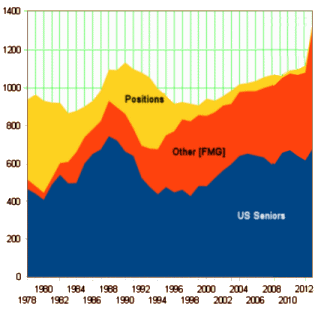A new “all in“ policy for this year’s match, along with an increase in the number of medical students, contributes to the increase in graduates choosing psychiatry. A total of 681 U.S. medical student seniors “matched” into psychiatry residencies in this year’s National Resident Matching Program [NRMP]. This is an increase from 616 in 2012, or from 3.9 percent to 4.2 percent of seniors selecting careers in psychiatry. The uptick in graduates entering the profession is good news for psychiatry, reversing a trend of several years in which the numbers were dropping. Last year’s figure of 616 was a decrease from 640 the year before and 670 in 2010…
This year the NRMP instituted an “all in” policy whereby residencies were required to enter all of their residency slots in the match. In past years, programs could participate in the NRMP by registering and filling some available residency positions, while also reserving some to be filled outside the match. In short, programs could decide which positions were “in” the match and which were “out.” So with the “all in” policy there were more slots offered in the match: in psychiatry, 1,360 positions were offered [compared with 1,118 in 2012]. And of the 1,360 slots, 1,330 were filled…
That’s odd. When I looked at it a month ago when the numbers came out, I saw that the number ooched up slightly, but it looked like the percentage of US Seniors picking psychiatry hadn’t changed. Oh well, I guess my slide rule’s finally getting old. But that "all in one" policy probably does explain why the total slots available went up:
March 15, 2013

For reasons I don’t really understand, psychiatry is offering a lot more positions this year [1360, up from 1118]. In spite of that, the flat-line continues in the recruitment of graduating US Seniors [681]. One can’t predict much from that because students choosing psychiatry vary a lot from year to year. But it has been a decade of "flatness." The difference is being made up by non-US Seniors, primarily FMG [foreign medical graduates]…
So, back to the Psychiatric News article:
Sidney Weissman, M.D., a former APA Trustee and president of the American Association of Directors of Psychiatric Residency Training, noted that the inclusion of all available slots in the Match does not necessarily reflect an actual increase in residency opportunities. Meanwhile, there has been an increase in U.S. seniors from 16,527 in 2012 to 17,856 in 2013…
Wait a minute. Somehow, those percentages up above [3.9% and 4.2%] don’t look quite right:
| Year |
US Seniors | to Psychiatry |
Actual % | Reported % |
|
|
||||
| 2012 | 16,527 | 616 | 3.73% | 3.9% |
| 2013 | 17,856 | 681 | 3.81% | 4.2% |
Because they aren’t. Old slide rule reclaimed. The moral of the story isn’t that psychiatry isn’t particularly attractive right now. We already know that. The moral is check the math of psychiatric articles. It tends to go fuzzy at just the right moment in just the right direction…
Retraction Notice! see comments
WTF! Can’t they be honest about anything?
Well, I think it depends on how you’re calculating it. If you look at the match results data from NRMP, at the bottom of Table 1 you see that 16,390 U.S. seniors actually matched somewhere in 2013. Thus, 681/16,390 = 4.155%. So it looks like there are 1466 U.S. seniors who either did not match anywhere, or chose to sell their souls to the pharma/insurance/consulting companies.
Sure but look at the ORANGE (FMG)– why are the available positions being increasingly taken by FMG’s?
Tom, I think it’s obvious why more and more FMG’s are going into psychiatry. It’s not a very competitive specialty, and gets paid on par with primary care specialties such as general internal medicine, family medicine, and pediatrics. If you look at the numbers from the 2012 match (page 3 of this pdf), the specialties with the highest number of FMGs are internal medicine, family medicine, pediatrics, and psychiatry. It’s not a coincidence.
BTW Mickey, will you be retracting your “fuzzy math” headline, given you own somewhat fuzzy math on this matter? I’m sure you’re not going to be like JAACAP and Paxil Study 329 here…
Absolutely retracted. Oh well, I can’t be Chairman at Brown anymore…
A bit of scary information embedded in a fairly bland recent Medscape article on physicians and “burnout”:
What was the number-one source of physician stress, even worse than insurance forms, the biggest word in the Stress Tag Cloud? Patients. Which specialty had the lowest percentage of burned-out members? Pathologists. It stands to reason. The less contact with those stressful patients, the less burnout. So. Which specialty had the SECOND-lowest percentage of burnouts? You guessed it! Psychiatrists. Which may be why they are so easy to lead off a cliff in the name of Evidence Based Medicine. They have so little patient contact anyway. Honestly, who would be attracted to a profession like that these days?
PS: I have met some really awesome foreign medical grads but I have to admit, at first it struck me that psychiatry was exactly the wrong field to go into if you were still struggling to understand the culture and language of your patients. Then I read the Medscape thing. Oh well. Guess it ain’t no thang …